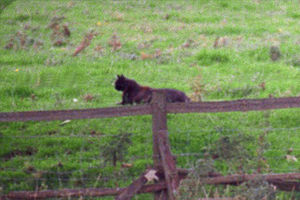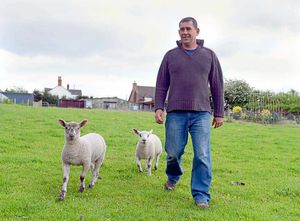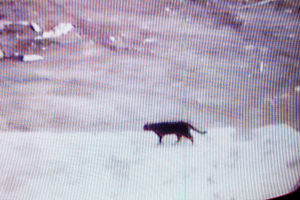Special feature: Could big cats be prowling Shropshire?
Grainy photographs showing the silhouettes of large, lithe creatures prowling the woodland.

Giant paw prints in the ground, farm animals being savaged by mysterious creatures which stealthily disappear, leaving a trail of carnage in their wake.
Stories about big cats stalking the Shropshire countryside are as old as the hills they are said to roam.
The debate has reopened once more after farmer Simon Mortimer said he feared a big cat might have attacked his sheep at Wistanswick, near Market Drayton. Days later, there were reports of a panther-like creature climbing a fence in Telford.
Mr Mortimer says that initially he thought it might have been attacked by a fox, but closer examination revealed that injuries were too extensive for a fox to have carried out the attack.

"I had a chat with a friend of mine who has been a farmer in the area for many years, and he said there was no way it could be a fox and that it was probably a big cat," he says.
"A fox just wouldn't take a lamb that big. A fox would take the carcass, but this had eaten nearly all the lamb, and it was clean – it chewed through the ribs even."
Bob Lawrence, director of wildlife at West Midland Safari Park in Bewdley, is not convinced.
He says it is perfectly possible that a big cat could live in the wild, and it is feasible that the odd one or two might surface from time to time.
But Mr Lawrence, who has worked at the park since it opened in 1973, says the idea that there are significant numbers of big cats stalking the countryside sounds fanciful.
"The stories have been going round as long as I can remember," he says. "In all that time, I have never seen an authentic picture, which you think would have happened by now. Every Tom, Dick and Harry has got a phone that can take a picture these days."

The one sighting that Mr Lawrence was convinced by was one was captured on video at Evesham around 15 years ago.
"That did appear to show a black cat, probably a leopard or jaguar, a leopard would be more capable of surviving the English winter.
"That I'm pretty sure was genuine, but all the other stuff, I'm not convinced.
"It is possible that a big cat could survive the English climate, but there was one expert recently who claimed there could be as many as 1,000 running around in England.
"If that is the case, that is 1,000 opportunities for people to come up with some evidence.
"I'm open minded, but I think it is unlikely."
So what about the Big Cat of Ludlow? In February, 1989, the body of an Asian jungle cat was found by the side of the road near Ludlow Castle, having apparently been hit by a car. A man brought it into Ludlow Museum where it was examined and identified, and paid to have it stuffed by a taxidermist.
At the time there were claims it had mated with domestic cats, leading to the birth of some pretty fearsome felines in the area. A super-sized pet cat called Jasper was even produced as evidence, with the suggestion that it had the markings of a jungle cat.
Mr Lawrence observes though, that for a so-called big cat, it wasn't really that big.
"A jungle cat is about a fifth of the size of a lion," he says.
"I think that was found to have escaped from a private collection, I think there was also one in Wem, but there is no real evidence apart from that."
There was a time of course, in the 1960s and 70s, when a pet tiger or cheetah was the must-have fashion accessory for the well-to-do. They were on sale in Harrods, and Mr Lawrence recalls a shop in Birmingham selling them during the 1970s. However, the 1976 Dangerous Wild Animal Act, introduced in response to Black Country "lion man" Lewis Foley who kept lions, tigers, a gorilla and crocodile in his back garden, made it near-impossible to keep big cats in a domestic setting.
As a result, many people simply freed their big cats into the wild, leading to a spike in the number of sightings. So what would have happened to these beasts? Is it not possible that some of their descendants could be roaming the woods and hills of Shropshire?
Mr Lawrence thinks it is unlikely, and believes the probability is that they would have simply died out.
"That was a long time ago now, and if there were to be big cats in the wild now, they would be third or fourth generation," he says.
"If they have been multiplying there would be proliferation, there would be a thousand. But where is the evidence?"
Television naturalist Gordon Buchanan, who earlier this year gave a talk in Oakengates, says it is perfectly possible that panthers or pumas could be prowling the countryside. But he says a lack of hard proof means the odds are now heavily stacked against it.
"I said about five years ago that, with everybody carrying mobile phones with cameras, we will soon have conclusive evidence if there were really big cats out there," he says. "So far that has yet to materialise. Having spent some time with big cats, I know they are expert at concealing themselves and hiding, so it is possible. But in the absence of hard evidence, I think it's looking less likely."
All of which backs up the position of the Department for the Environment, Food and Rural Affairs, which says while there has been the occasional escape from zoos or illegal ownerships, there is no evidence of a breeding population.
The National Farmers Union has in the past acknowledged that there may be big cats in the wild, but it does not appear to have been an issue of major concern.
NFU West Midlands spokesman Oliver Cartwright says: "We are not aware of any issues with big cats, but that doesn't mean that they aren't out there, if we were to see some concrete evidence."
But of course, this does nothing to explain the injuries to Simon Mortimer's lamb.
Mr Lawrence believes it is another, far less exotic predator which is most likely to have carried out that attack.
He says: "You would be amazed what half a dozen badgers can do. They would have no problem in eating a ewe, all they leave behind is an unpleasant smell."





